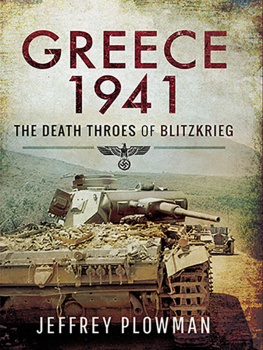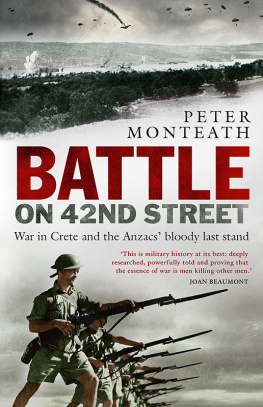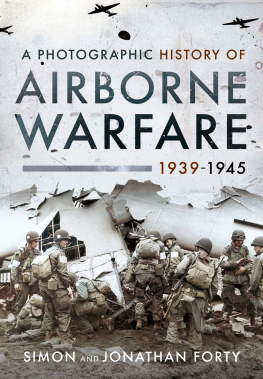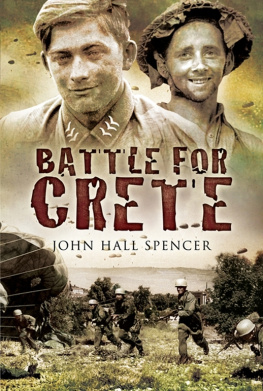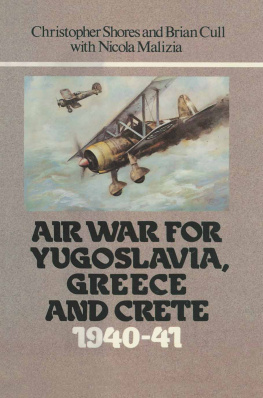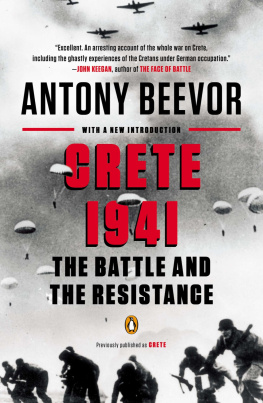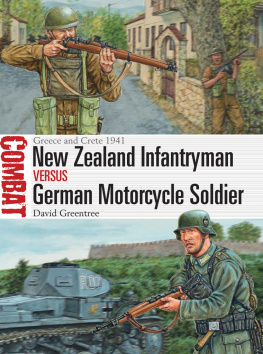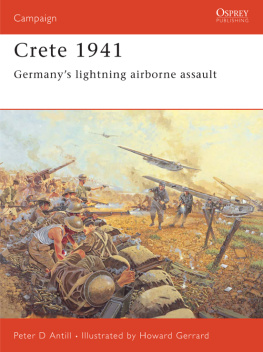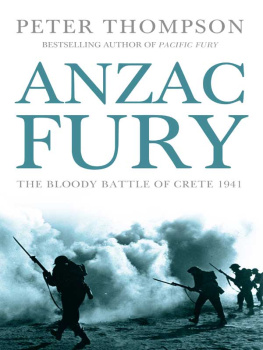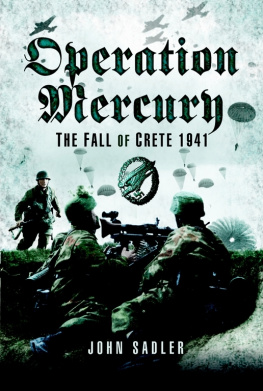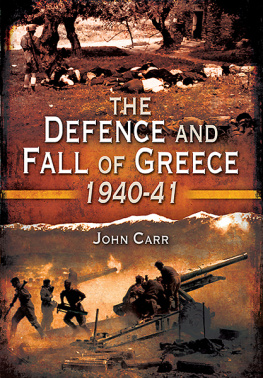
Panzers in the Peneios. Frustrated by demolitions set off by New Zealand troops in the Peneios gorge, German armour took to the water. (Alexander Turnbull Library)

First published in Great Britain in 2013 by
PEN & SWORD MILITARY
an imprint of
Pen & Sword Books Ltd,
47 Church Street,
Barnsley,
South Yorkshire
S70 2AS
Copyright Jeffrey Plowman, 2013
ISBN 978 178159 248 9
eISBN 9781473832084
The right of Jeffrey Plowman to be identified as Author of this Work has been asserted by him in accordance with the Copyright, Designs and Patents Act 1988.
A CIP record for this book is available from the British Library.
All rights reserved. No part of this book may be reproduced or transmitted in any form or by any means, electronic or mechanical including photocopying, recording or by any information storage and retrieval system, without permission from the Publisher in writing.
Typeset by CHIC GRAPHICS
Printed and bound by CPI Group (UK) Ltd, Croydon, CR0 4YY
Pen & Sword Books Ltd incorporates the imprints of Pen & Sword Archaeology, Atlas, Aviation, Battleground, Discovery, Family History, History, Maritime, Military, Naval, Politics, Railways, Select, Social History, Transport, True Crime, and Claymore Press, Frontline Books, Leo Cooper, Praetorian Press, Remember When, Seaforth Publishing and Wharncliffe.
For a complete list of Pen & Sword titles please contact
Pen & Sword Books Limited
47 Church Street, Barnsley, South Yorkshire, S70 2AS, England
E-mail: enquiries@pen-and-sword.co.uk
Website: www.pen-and-sword.co.uk
Contents
Photograph Sources
I wish to thank the following for photographs and information: Lee Archer, Jeff Bell, Peter Brown, Ian Collins, Phil Deed, Claude Gillono, Robert Gregory, Michael Grieve, Herv Jojot, Shane Lovell, Mark MacKenzie, Wes Olsen, Patrick Ott, Dinko Predoevi, Perry Rowe, Heinz Richter, Steffen Rossler, Peter Scott, Katy Sinton, Mike Smythe, Larry Te Keoti, Malcolm Thomas, Irena Tojcic, Douglas White and Shaun Winkler.
I am grateful to the following veterans and families of veterans for making their photographs available over the years: Hans Bender, Jack Dalton, Charlie Grainger, Frank Horton, Stratton Morrin, Robert Simpson, Mervyn Sim and Wilhelm Weier.
I am also grateful to the following archives and organizations for making photographs available to me: the Alexander Turnbull Library, the Army Museum of Western Australia, the Bundesarchiv, the Imperial War Museum, the Mdiathque de la Dfense, dIvry (ECPAD) and the Regimental Historical Centre (Burnham).
Introduction
P eople seem fascinated by heroic defeats, Custers Last Stand, the Battle of Balaclava or the Germans at Stalingrad to name but a few. The battle for Crete in 1941 is another one of these. It seems that hardly a year goes by in New Zealand and Australia without some new book being published on the subject. It is not hard to see why. The struggle of the ill-equipped ANZAC troops against the elite troops of Germany falls into this category of a heroic defeat. At the same time there is a similar fascination in the opposite hemisphere of the world, a fascination largely centred around the elite fallschirmjger and how they overcame all odds to take this island. But in terms of the war in the Mediterranean there is more to this than just Crete. What has largely been neglected is what went before, the campaign through the lower Balkan countries of Jugoslavia and Greece.
The reality is that the epic struggle on this small island in the Aegean was merely the terminal phase of a dispute between Greece and Italy that can be traced back to before the First World War and their clashes over Albania and the Dodecanese Islands. Though Albania came into existence in 1913 at the end of the Balkan Wars, within this new state was a region that many Greeks regarded as having strong connections to the former Greek region of Epirus. In 1913 ethnic Greeks living there started to use the term Northern Epirus, proclaiming it an autonomous region in the spring of the following year and one recognized by the Albanian government. This territory proved to be short-lived, collapsing along with Albania at the start of the First World War. Greece took over control of this region and held it until 1917 when they were driven out by the Italians. Likewise, the Dodecanese were largely inhabited by Greeks but Italy occupied the islands during the Turco-Italian War of 191112. Italy initially agreed to return them to the Ottoman Empire after signing the Treaty of Lausanne but the general vagueness of the treaty allowed Italy provisional administration of these islands and Turkey eventually renounced all claims to them.
Italy and Greece came into conflict again after the First World War. At the Paris Peace Conference in 1919 the Italian government discovered that Greece had been promised large tracts of Asia Minor for its support during the war. Upset by the Greek occupation of Western Anatolia, the Italian delegation walked out of the conference and did not return for several months. In the meantime they occupied part of south-west Anatolia, threatening the city of Smyrna. The Greeks took exception to this and landed a force of 20,000 there, securing the city and then advancing deeper into Anatolia. The Turks retaliated, routing the Greek force in Anatolia and, with Italian aid, eventually re-took Smyrna in September 1922.
The final phase of this conflict erupted in 1923 over the so-called Corfu Incident. In August that year an Italian general and three of his assistants were murdered within Greek territory. Italys new prime minister, Benito Mussolini, sent an ultimatum to Greece demanding millions in reparation money and the execution of the killers. When the Greeks could not identify them the Italians retaliated by bombarding and then occupying Corfu in the Ionian Islands, a move no doubt motivated by the strategic position it occupied at the entrance to the Adriatic Sea. Thereafter, largely under the premiership of Eleftherios Venizelos, a period of normalization of relations occurred between the two countries culminating in the signing of a friendship treaty in 1928. In fact, Italy was still regarded as a friendly state as late as 1935 despite invading Ethiopia from Somalia and Eritrea, a move that saw the imposition of economic sanctions by the League of Nations. Though these were lifted after the Italian annexation of that country in 1936, Italy seemed less inclined to maintain friendly relations with the British in the Middle East, sending troops to support General Franco when civil war broke out in Spain in 1936, and expanding their influence in the western Mediterranean by occupying the Balearic Islands. A further cause for concern was the formation of the Rome-Berlin axis that year, though this was somewhat relieved by the signing of the Anglo-Italian Joint Declaration in January 1937. Not that this signalled an improvement in relations between Italy and Greece, and in fact the situation continued to deteriorate culminating at the end of the year in the announcement that Italy had joined Germany and Japan in their Anti-Comintern Pact against the Communist International.
Chapter One
The Greco-Italian Conflict, 1940-1


